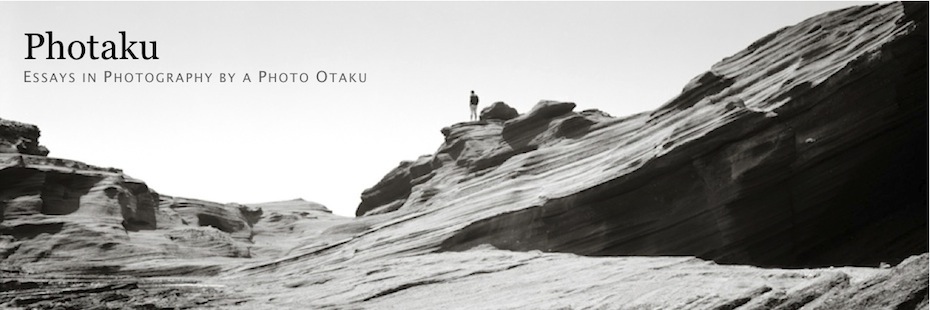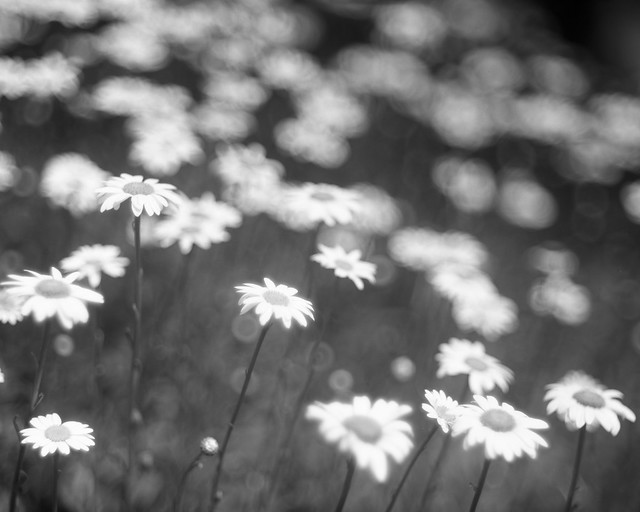Discipline Is Not Digital
I raised the issue of “rigid technical discipline” in the context of the Group f/64 guys in my latest essay, f(ascism)/64, as an adjunct to the strict aesthetic standards of “pure straight photography” that the group promoted. And while I question the strictness of their purist photographic ideology, I do admire their discipline (although even there I think the likes of Ansel Adams sometimes goes overboard — I’ll never be a Zone System adherent). I mention this now only because I received a comment from blinkd.ca this morning on a recent Flickr upload which reads “I enjoy your work. There is a discipline in what you do. Very nice.” I chuckled when I read this because the shot in question — a test shot with a British Air Ministry 8″ Pentac WWII aerial recon lens — did in particular indeed require a great deal of discipline. Here’s the shot:
While I was driving home with one sheet of 4×5 film left and looking for a floral scene to shoot, I spied this planter full of hundreds of blooming daisies. As I was in bit of a hurry I thought it would be a perfect subject because there were so many blooms that it would be easy to set up the Speed Graphic and snap a shot just about anywhere in the bunch to get good shot. After all, this was only to test the depth of field and bokeh of the lens, not to submit to a gallery exhibition. Well, it ended up being one of the longest shots that I ever set up to take. Part of the reason was because I had only one sheet of film and I didn’t want to blow it. But the more significant reason is that despite appearing to be an easy scene to derive a good shot from, each time I set up and framed the shot, there seemed to be at least one thing marring it: an unseemly broken off stem, an awkward background, a clutter in the foreground, an odd empty spot, a too narrow angle on the focal point, blown out highlight, etc. It got to be so long in the very hot sun that the temporary make-shift lens mount of craft foam and tape started to soften in the heat and slip from the lensboard! It seemed as if at every turn, once I had changed the framing or angle or distance to better the shot, something else moved in to ruin it. This went on for about 20 minutes — for one stupid test shot! I almost simply packed up to leave, thinking that the Fotographic Fates were simply mocking me and it just wasn’t meant to be even though it initially seemed to be a ready-made shot. The problem with quitting, though, is that once you’re 20 minutes into it you’ve committed. Barring a thunderstorm, to walk away without a shot after such effort would seem even more ridiculous.
Call it stubborn determination if you will, but the effort expended for this test shot also bespeaks of the discipline one must cultivate with analog film, ESPECIALLY large format. It would have been easier with medium format, but I still very much imagine the same trials because I tend to shoot medium format with the same eye and attitude. 35mm would have been the easiest because I would not have cared as much about blowing one frame of cheaper film. And of course, if I had been using my Canon 40D digital camera I would have happily shot 100 frames, checked them on-site, and assume that at least a handful would be keepers. That’s the advantage of digital. Super easy, super convenient, and often super great results. Cheaper too after the initial outlay for camera, lenses, and memory cards. However, those very same positive attributes also contribute to what for me is a big negative attribute — it encourages a lack of discipline in scouting, composing, and taking a shot. That’s not to say you cannot be thoughtful, deliberate, and disciplined with a digicam; it’s just that the very nature of the technology is geared for a kind of convenience that tempts one to shoot like crazy — because you can — and that can lead to becoming lazy and sloppy and undisciplined in your shooting. For some people that kind of undisciplinedness is itself a positive attribute in that it can lead to spontaneous creativity, a chance masterpiece, and surprising contingency (often associated with true snapshots). Just look at the proliferation of smartphone photos, some of which attain high degrees of artistry with or without the editing apps you can use with them. I have done and occasionally still do partake of this kind of digi-snapping. On the other hand, I see a great value in being forced — by both the technology and an inner sense of personal challenge — to be more deliberate and disciplined in making an exposure with film. In a very real way, composing on the ground glass under certain conditions, with certain lenses, and certain films that one might have certain developers in mind for, trains your vision in multiple dimensions. Shapes, light, shadow, gradations, edges and angles, positive and negative spaces, focus and blur — all these things come into consideration. You see more because you look more. And you look more because of the time and effort (and implicit expense) needed for the shot.
This morning I loaded four 5×7 film holders with plans to test the same lens on the Ansco 5×7 this time. Sunlight seems iffy at the moment — coming in and out with a forecast of partly sunny this afternoon. I really want to test coverage with this lens on the 5×7 because it has great potential for not only “floral recon” shots like the one above, but also soft focus ethereal portraiture (precisely the kind of stuff the Group f/64 chaps detested). However, I might have to wait for better conditions, potentially adding hours if not days to the 10-20 minutes that it will take per shot….
Musings & Experiments
- Collodion Bastards and the Indian Connection
- Microtypes
- Figalotypes
- R.B. Graflex Series D Lens Catalog
- The R.B. Graflex Series D Restoration Project
- Worldwide Pinhole Photography Day 2012
- It’s Official: I’m a Large Format Whore
- A New “Book” Project?
- No Longer a Kodak Shareholder
- Kodak Restructures and Brings My Shares Back to Break Even
Latest Flickr Post






